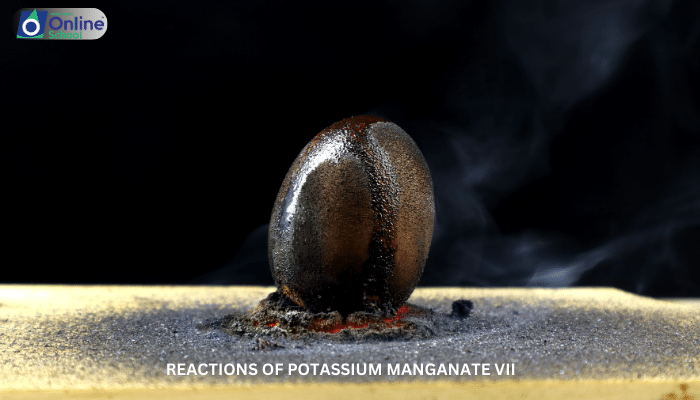
Learning Outcomes:
i. Define potassium manganate VII (KMnO4) and its chemical formula.
ii. Describe the physical properties of potassium manganate VII, including its color, solubility, and hygroscopicity.
iii. Explain the oxidizing nature of potassium manganate VII and its role in redox reactions.
iv. Analyze the reactions of potassium manganate VII with ferrous sulfate, oxalic acid, and Mohr's salt, writing balanced chemical equations.
v. Identify the applications of potassium manganate VII in various fields, such as water treatment and disinfecting agents.
Introduction
Potassium manganate VII (KMnO4), commonly known as potassium permanganate, is a deep purple crystalline compound with a strong oxidizing character. It finds applications in various fields, including water treatment, disinfecting agents, and analytical chemistry. In this lesson, we will explore the reactions of potassium manganate VII with ferrous sulfate, oxalic acid, and Mohr's salt, highlighting its versatility as a chemical reagent.
i. Physical Properties of Potassium Manganate VII
Potassium manganate VII exhibits distinct physical properties:
Color: Potassium manganate VII is a deep purple crystalline solid, often appearing as needle-like crystals.
Solubility: Potassium manganate VII is moderately soluble in water, forming a deep purple solution. The solubility increases with temperature.
Hygroscopicity: Potassium manganate VII is slightly hygroscopic, meaning it absorbs moisture from the air to a limited extent.
ii. Oxidizing Nature of Potassium Manganate VII
Potassium manganate VII is a strong oxidizing agent, readily gaining electrons by oxidizing other compounds. This oxidizing ability is due to the presence of manganese in the +7 oxidation state, which is highly unstable and tends to lose electrons to attain a more stable lower oxidation state.
In redox reactions, potassium manganate VII acts as an electron acceptor, reducing itself to manganese(II) ions (Mn2+). The reduction of potassium manganate VII is accompanied by a color change from purple to colorless or pale pink.
iii. Reactions of Potassium Manganate VII
Potassium manganate VII undergoes various reactions, demonstrating its oxidizing potential:
Reaction with Ferrous Sulfate (FeSO4): Potassium manganate VII reacts with ferrous sulfate (FeSO4) in an acidic solution, oxidizing ferrous ions (Fe2+) to ferric ions (Fe3+). The reaction is accompanied by a color change from purple to pale yellow.
Reaction with Oxalic Acid (H2C2O4): Potassium manganate VII reacts with oxalic acid (H2C2O4) in an acidic solution, resulting in the oxidation of oxalic acid to carbon dioxide (CO2) and water (H2O). The reaction is accompanied by a color change from purple to colorless.
Reaction with Mohr's Salt (FeSO4(NH4)2SO4≈6H2O): Potassium manganate VII reacts with Mohr's salt (ferrous ammonium sulfate) in an acidic solution, oxidizing ferrous ions (Fe2+) to ferric ions (Fe3+). The reaction is accompanied by a color change from purple to dark green.
iv. Applications of Potassium Manganate VII
Potassium manganate VII finds applications in various fields:
Water Treatment: Potassium manganate VII is used as a water disinfectant to eliminate harmful microorganisms.
Disinfecting Agents: Potassium manganate VII is employed as a disinfectant in various applications, including surface disinfection and wound cleaning.
Analytical Chemistry: Potassium manganate VII is used as an oxidizing titrant in volumetric analysis, particularly for the determination of iron(II) ions and oxalic acid.
Potassium manganate VII is a versatile and important reagent due to its strong oxidizing properties. Its reactions, such as those with ferrous sulfate, oxalic acid, and Mohr's salt, demonstrate its diverse applications in water treatment, disinfection, and analytical chemistry. Understanding the chemistry of potassium manganate VII provides insights into its practical significance and the role of redox reactions in various fields.